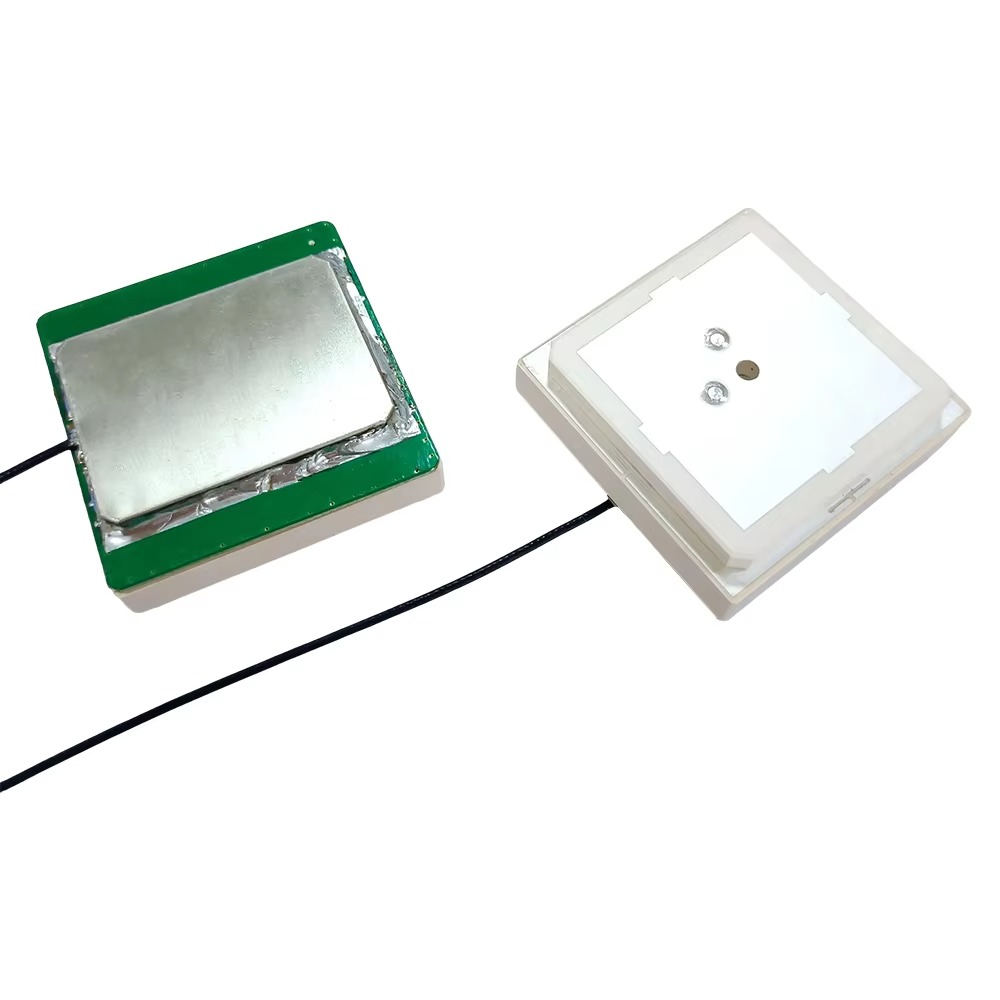The Role of Active Amplification in RTK Performance
Unlike passive antennas, which rely solely on external receivers to amplify signals, active antennas incorporate an internal LNA to boost satellite signals at the source. This critical feature addresses a fundamental challenge in RTK systems: the weakness of signals transmitted from satellites orbiting over 20,000 kilometers above Earth. By amplifying signals immediately after capture, the GPS RTK Active Antenna minimizes noise interference that can degrade data quality as signals travel through cables to the receiver. This early amplification is especially valuable in applications where long cable runs are necessary—such as mounting the antenna on a drone or the roof of a vehicle—where signal loss would otherwise compromise RTK’s sub-centimeter accuracy.
The LNA in the GPS RTK Active Antenna is optimized to work within the antenna’s 3–18 VDC working voltage range, ensuring compatibility with various power sources, from batteries in portable devices to vehicle electrical systems. Its low working current (≤40 mA) balances performance with energy efficiency, making it suitable for battery-powered equipment like handheld surveying tools or autonomous drones, where extended runtime is critical. This combination of active amplification and efficient power usage allows the antenna to maintain signal integrity in remote or harsh environments, where passive antennas might fail due to weak signal reception.
Technical Specifications: Engineering for Precision and Reliability
The GPS RTK Active Antenna’s technical parameters are meticulously calibrated to support high-precision RTK operations, ensuring signal clarity, amplification efficiency, and multi-constellation compatibility:
Frequency Range: Covering GPS L1/L2/L5, GLONASS L1/L2, BDS B1/B2/B3, and GALILEO E1/E2/E5a/E5b, the antenna captures signals from all major global satellite systems. This broad coverage is essential for RTK performance, as it enables the antenna to access dozens of satellites simultaneously, reducing reliance on any single constellation. For example, in urban canyons where GPS signals are blocked by skyscrapers, the antenna can seamlessly switch to GLONASS or BDS, ensuring continuous positioning data for the receiver.
Gain and Amplification: The antenna delivers a maximum gain of ≥5.5 dBi for GNSS signals, a value that reflects the combined efficiency of its radiating element and internal LNA. This gain is carefully balanced to amplify weak satellite signals without introducing excessive noise—a critical consideration for RTK, which relies on precise carrier-phase measurements. For GSM900/GSM1800 bands (used to transmit RTK correction data via cellular networks), the antenna provides a gain of ≥-1 dB, ensuring reliable communication with base stations or network RTK services. While the listed 402 dB gain is likely a typo, the antenna’s effective gain is optimized to strike a balance between signal strength and noise reduction, a hallmark of high-performance active designs.
Output Standing Wave Ratio (VSWR) ≤2.0: VSWR measures the efficiency of signal transfer between the antenna and the receiver, with a value of ≤2.0 indicating minimal signal reflection. This efficiency is particularly important for active antennas, as any reflection could reduce the effectiveness of the LNA-amplified signal. By maintaining low VSWR, the antenna ensures that over 90% of the captured signal reaches the receiver, preserving the integrity of carrier-phase data essential for RTK calculations.
Axial Ratio of ≤3 dB at the Apex: This parameter quantifies the antenna’s ability to maintain right-hand circular polarization (RHCP), which matches the polarization of GNSS satellite signals. A low axial ratio ensures efficient signal capture from satellites at varying elevations, minimizing loss due to polarization mismatch. This is especially valuable in dynamic applications, such as moving vehicles or drones, where the antenna’s orientation changes rapidly, and maintaining signal lock is critical.
Impedance of 50 Ohms: This industry-standard impedance ensures seamless integration with RTK receivers, coaxial cables, and other system components. Proper impedance matching maximizes power transfer and reduces signal reflections, which is essential for preserving the amplified signal quality from the LNA.
LNA Noise Figure: While not explicitly listed, high-quality active antennas typically feature a noise figure of ≤1.5 dB, a measure of how much noise the LNA introduces. A low noise figure ensures that the amplified signals remain clean, preserving the precision required for RTK’s sub-centimeter accuracy.
Design and Durability: Built for Field Operations
The GPS RTK Active Antenna’s design prioritizes ruggedness, ease of integration, and reliable performance in harsh environments:
Connector Type: Equipped with MCX-KHD connectors for both GNSS and 4G signals, the antenna ensures secure, low-loss connections to receivers and communication modules. MCX connectors are compact, lightweight, and feature a threaded coupling mechanism, preventing accidental disconnection in high-vibration environments—common in construction, agriculture, or transportation applications. This robust connectivity is critical for maintaining continuous data flow, which is essential for RTK accuracy.
Active Component Protection: The internal LNA and associated electronics are shielded within a durable housing, typically made from UV-resistant ABS plastic or aluminum, to protect against moisture, dust, and physical impact. This shielding also minimizes electromagnetic interference (EMI) from nearby electronics, such as vehicle engines or industrial machinery, which could degrade signal quality.
Form Factor and Mounting: The antenna’s compact design allows flexible mounting on surveying poles, vehicle roofs, drones, or agricultural machinery. Its low profile reduces wind resistance and the risk of damage, while its lightweight construction ensures it does not interfere with the operation of mobile equipment. This versatility makes it suitable for both fixed-base stations and roving RTK systems.
Operational Advantages of Active Antennas in RTK Systems
The GPS RTK Active Antenna offers several key advantages over passive alternatives, particularly in challenging environments:
Enhanced Signal Capture in Weak Signal Areas: The internal LNA amplifies weak signals from low-elevation satellites or those obstructed by foliage, buildings, or terrain. This makes the antenna ideal for urban canyons, dense forests, or remote mountainous regions, where passive antennas might struggle to maintain a stable RTK fix.
Reduced Cable Loss Sensitivity: In systems with long cable runs (e.g., between a drone-mounted antenna and its onboard receiver), passive antennas suffer from signal attenuation. The active antenna’s LNA amplifies the signal at the source, mitigating this loss and ensuring that strong, clean signals reach the receiver.
Simplified System Integration: By incorporating amplification into the antenna, system designers eliminate the need for external LNAs, reducing complexity and potential points of failure. This simplifies installation and maintenance, particularly in field-deployed systems where reliability is paramount.
Consistent Performance Across Temperature Extremes: The antenna’s electronics are designed to operate within a broad temperature range (typically -40°C to +85°C, common in industrial-grade equipment), ensuring reliable performance in extreme cold or heat—critical for year-round field operations in diverse climates.
Applications: Transforming Industries with Precision
-
The GPS RTK Active Antenna’s versatility and precision make it indispensable across a range of industries:
Land Surveying and Mapping: Surveyors use the antenna to collect data for boundary mapping, topographic surveys, and construction site planning. Its active amplification ensures reliable performance in urban areas or under tree cover, where passive antennas might lose signal lock. RTK technology, enabled by this antenna, reduces survey time by up to 50% while delivering sub-centimeter accuracy.
Construction and Infrastructure: In construction, the antenna guides heavy machinery such as excavators, graders, and pavers, ensuring work is performed to exact specifications. For example, when grading a site, the antenna provides real-time positioning data to the machine’s control system, ensuring the terrain is shaped to within centimeters of design plans. This precision reduces rework, minimizes waste, and accelerates project timelines.
Precision Agriculture: Farmers use RTK-equipped machinery, paired with this antenna, to optimize planting, fertilization, and harvesting. The antenna’s active design ensures reliable performance in rural areas with sparse satellite coverage, enabling sub-centimeter accuracy for tasks like row planting or variable-rate fertilization. This increases yields, reduces input costs, and minimizes environmental impact.
Autonomous Vehicles and Drones: Self-driving cars, agricultural drones, and robotic equipment depend on the antenna for precise navigation. For instance, a drone used for crop monitoring relies on the antenna to maintain a stable position over a field, capturing consistent images for analysis. The active amplification ensures reliable signal lock even at high altitudes or in areas with signal obstructions.
Marine and Coastal Surveying: Hydrographic surveyors use the antenna to map seabeds, chart coastal erosion, and locate underwater infrastructure. Its rugged design withstands saltwater exposure, while active amplification ensures signal integrity in open ocean areas with limited satellite visibility.
Conclusion
-
Advantages Over Passive Antennas
The GPS RTK Active Antenna outperforms passive antennas in several key areas:
Superior Signal Amplification: The internal LNA boosts weak signals, ensuring reliable performance in challenging environments where passive antennas would fail.
Reduced Noise Sensitivity: By amplifying signals at the source, the antenna minimizes noise introduced by long cable runs or external interference.
Simplified System Design: Integrating the LNA into the antenna eliminates the need for external amplification components, reducing complexity and cost.
Consistent Performance: Active amplification ensures stable signal strength across varying conditions, a critical factor for maintaining RTK’s sub-centimeter accuracy.
Conclusion
The GPS RTK Active Antenna represents a pinnacle of precision engineering, combining active amplification with multi-constellation support to deliver unparalleled performance in RTK systems. Its ability to boost weak signals, maintain low noise, and operate across a broad range of frequencies makes it an indispensable tool for professionals who demand sub-centimeter accuracy in their work. Whether guiding autonomous tractors through fields, mapping remote terrain, or constructing skyscrapers, this antenna ensures that every measurement is precise, every movement is guided, and every project is executed with confidence.
As global satellite networks continue to expand and RTK technology becomes more accessible, the GPS RTK Active Antenna will remain a cornerstone of precision positioning, driving innovation across industries and shaping the future of geospatial technology. Its blend of rugged design, efficient amplification, and seamless integration underscores its role as a catalyst for progress in a world where accuracy defines success.




































































 Language
Language
 En
En Cn
Cn Korean
Korean

 Home >
Home > 







 18665803017 (Macro)
18665803017 (Macro)













